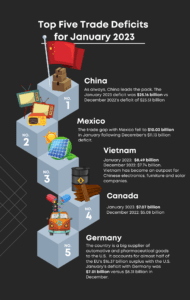The U.S. economy kicked off 2023 with a $68.3 billion goods and services trade deficit in January, up 1.6% from the December deficit, according to data released on Wednesday by the Bureau of Economic Analysis (BEA).
The January increase in the goods and services deficit reflected a decrease in the goods deficit of $0.6 billion to $90.1 billion and a decrease in the services surplus of $1.7 billion to $21.8 billion. Year-over-year, the goods and services deficit decreased by $19.2 billion, or 21.9% from January 2022.
Stripping out services from the equation, the January goods trade gap was $91.08 billion on a Census basis. This figure is less than the January 2022 goods deficit of $106.75 billion, but more than the $85.34 billion deficit recorded in January 2021.
See CPA’s Trade Database for a closer look at the recent trade figures.
 When oil exports are excluded, the goods trade gap is almost the same at $90.08 billion. The U.S. was a net importer of crude oil in January, exporting $8.56 billion worth of crude and importing $13.87 billion.
When oil exports are excluded, the goods trade gap is almost the same at $90.08 billion. The U.S. was a net importer of crude oil in January, exporting $8.56 billion worth of crude and importing $13.87 billion.
The U.S. exported $4.5 billion worth of natural gas, however, and imported around $1.1 billion, so petroleum barely moved the needle on the trade deficit.
The U.S. posted its largest-ever goods trade deficit in 2022 at $1.18 trillion.
“The economy continues to pile up large monthly deficits. In January alone, we had a $22.7 billion deficit in autos and parts, and a $1.5 billion deficit in semiconductors,” said CPA chief economist Jeff Ferry. “It will be very interesting to see if last year’s legislation will be able to turn these deficits around.”
The dollar is not helping matters.
The currency rose 2.03% against the core currencies of the world, including the Euro. It is up 7.7% over the last 12 months in the forex markets.
“Last year, the dollar rose 5.2% against the broad basket of currencies. Our new Currency Misalignment Monitor shows it is 11% overvalued against the basket and overvalued by 18% against the Chinese yuan and 27% against the Japanese yen,” Ferry said. “What’s worse is that the current outlook, with the Fed talking tough about raising rates and most European and Asian central banks taking a more dovish line, is that the dollar is likely to creep up further in the next few months. This is bad news for U.S. producers.”
Deficits were recorded with both USMCA partners and the European Union, as usual.
Moreover, trade policies such as tariffs, coupled with geopolitical tensions, have led to the lowest China trade gap for the month of January since 2011 when the deficit stood at $23.35 billion at the time, based on Census data.
Top Five Exports
The top five remain unchanged in terms of items. These are the usual export leaders. Of the top five, industrial machines are usually the only source of surplus on a regular basis. Pharma and autos are a constant drag on the deficit as the U.S. imports more than it exports for both items.
| Product | January 2023 | December 2022 | Monthly Change |
| Pharmaceuticals | $10.08 billion | $7.31 billion | +$2.75 billion |
| Industrial machinery | $5.83 billion | $5.76 billion | +$74 million |
| Passenger cars | $5.72 billion | $5.41 billion | +$314 million |
| Auto parts | $5.43 billion | $4.74 billion | +$703 million |
| Semiconductors | $5.09 billion | $5.20 billion | -$110 million |
Top Five Imports
Semiconductors can sometimes be counted on to add to the surplus side of the trade equation, but not this month. The U.S. imported $6.57 billion worth of chips, mostly all of them from Asia.
| Product | January 2023 | December 2022 |
Monthly Change |
| Pharmaceuticals | $17.29 billion | $16.30 billion | +$921 million |
| Passenger cars | $16.27 billion | $14.89 billion | +$1.38 billion |
| Cell phones | $12.05 billion | $10.42 billion | +$1.62 billion |
| Auto parts | $11.70 billion | $11.43 billion | +$269 million |
| Electronic apparatus | $8.81 billion | $8.03 billion | +$780 million |
Worth noting, Washington’s newest turn-of-phrase for dealing with the China trade relationship is to “work with allies” to remap American supply chains. The trade deficit with Mexico, Canada and the European Union for the month of January was $32.77 billion. The trade gap with China was $25.16 billion. When Vietnam is added to the mix, the number comes out to $33.56 billion for January 2023. Two countries account for a bigger trade deficit than the already big gap between the U.S. and its biggest free trade zone partners, and the rich EU.
Record U.S. Goods Trade Deficit in 2022 As Electronics, Vietnam Imports Rise












